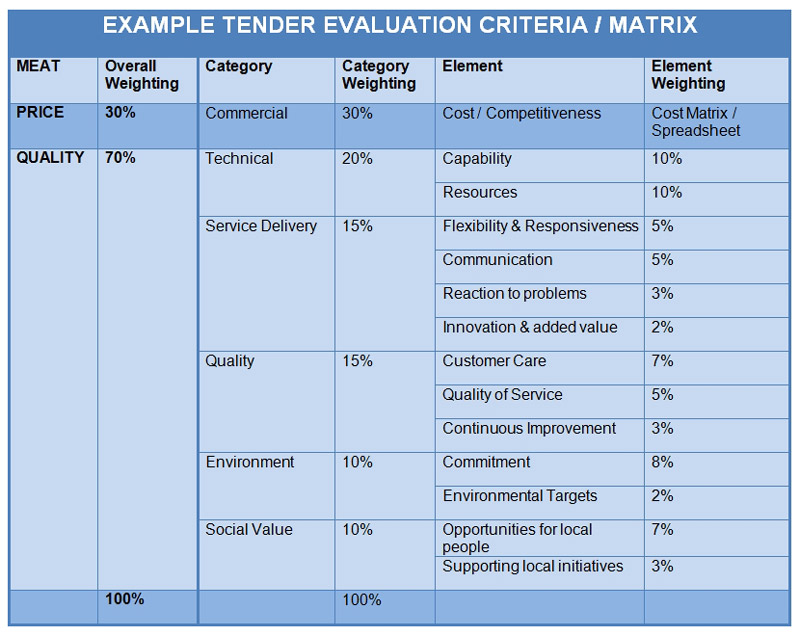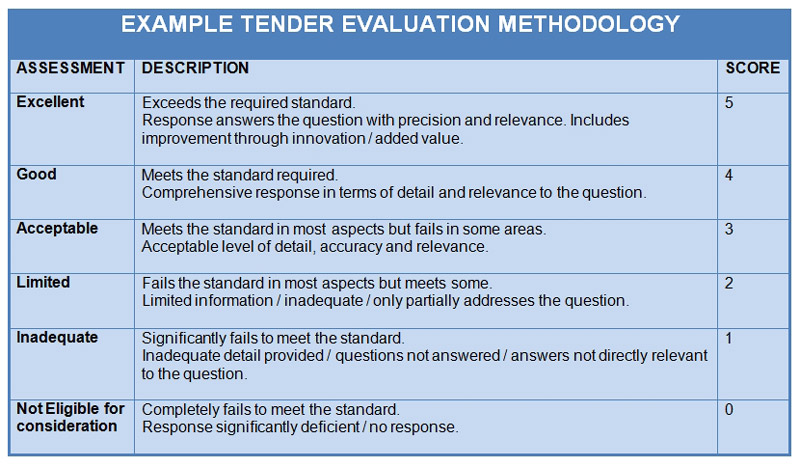Tender Evaluation Criteria and Tender Evaluation Methodology
Understanding the Tender Evaluation Criteria and Tender Evaluation Methodology is a vital part of the Bid Manager’s toolkit. Using them can help you to qualify the tender opportunity and improve your score.
Tender Evaluation Criteria
PQQs and tenders will often include a guide on how they are marked. Below is an example tender evaluation criteria or matrix. It shows a tender evaluation using weighted criteria:

They all look different and criteria differs depending on each customer’s needs. The scoring can range from simple percentage splits to complex weighting systems. But the basic principles of tender evaluation criteria remain the same.
Top Tip: If you don’t get this ask for it – it’s so useful. It is not an unreasonable request.
MEAT – Price vs Quality
Pre qualification questionnaires (PQQs) will not normally have any pricing element. However, they often have some mandatory elements. For example: minimum insurance requirements with a ‘Pass / Fail’ evaluation.
Tenders tend to be based upon a mix of price and quality. This is known as Most Economically Advantageous Tender – MEAT. Price is your charge. Quality relates to your written response to information questions.
Price / Quality split is the first thing to look at. It gives you an immediate guide to how the procurement process is being viewed by the customer.
The example above shows a split of Price: 30% / Quality: 70%. Therefore quality of the service/product is more important than price. Conversely a split of Price: 70% / Quality: 30% indicates a commodity-based purchase. Where price is important you need to sharpen your pencil or no bid!
Price
Pricing for tenders normally involves completing an Excel spreadsheet or Word table. You may be offering a single overall price or it might be split into many parts. Each tender will show you how price is evaluated. Typically price is scored relative to the average price submitted (weighted averages). Meaning something like:
- Lowest price gets maximum score
- Highest price gets lowest score
- Others are scored in relative to how close / far they are to the lowest price
Quality
Tender evaluation criteria for quality will often be split into categories (see example above). These can each have a weighting applied according to their perceived importance to the customer. Sometimes each category is sub-divided showing individual elements and their specific value. Often these relate to individual questions.
In this example ‘Technical’ has the highest potential score. ‘Capability’ and ‘Resources’ could be two questions within that section, each worth 10%.
Tender Evaluation Methodology
This shows you how each Quality written response will be assessed. This is often called the tender evaluation methodology. It will look something like the example below:

This can vary from a generic ‘Excellent’ to ‘Not Eligible’ (shown above in Assessment column). Some have valuable information on written response requirements (Description column).
The difference between the top score and the next best (Excellent vs Good in example) shows you what to write to get top marks. In this case you need to exceed their requirements, add value and innovate. Similarly, you can look at what constitutes a poor response and take that as a guide of what not to do.
Once you understand what is required, use these tips on writing tender responses.
Many tender evaluation methodologies ask you to demonstrate how you will achieve the requirement(s). This can be supported by using examples and evidence in your response.
Once again, they are all different depending on customer requirements. But they follow the same principle.
How Tenders are Scored
When organisations tender a contract they often form a tender panel or procurement team. This cross- functional group can include procurement, management, directors, HR etc. They score the bids and their results are pooled then averaged out to get final scores. Not all members of the team always see the pricing part. This system ensures fairness and a balanced view.
Each question might have an individual maximum mark. Each bidder will then have their score weighted against the percentage value. To keep it simple, what I look for is the percentage split (as shown in the example tender evaluation criteria / matrix). Then I look at maximum scores for each question. This tells me which parts / questions carry the most value.
If you want help with tendering, contact us for an informal chat about our tender consultancy services.
Summary – Using the Tender Evaluation Criteria and Evaluation Methodology
Hopefully this guide provides you with a good understanding of tender evaluation. Now you need to use it to improve your tendering success. Here are some priority actions:
- Use the tender evaluation criteria to qualify the tender – if you don’t think you can score high then don’t bid
- Plan ahead and allow time for checking
- Concentrate your initial efforts on answering the high-scoring questions – the lower value questions can wait till later
- Analyse the tender evaluation methodology – understand what makes a top response
- If unsure – ask for clarification
Anyone got anything else to add on this subject?


We get a lot of tenders heavily weighted on pricing. I can understand from a buyer’s POV why they’d do this but find it causes false or unrealistic proposals that can never be maintained. In turn this causes problems down the line for the buyer/supplier relationship.
Some industries face this regularly and it is very frustrating. But when you do get a better P/Q weighting you might then beat the competition if they’ve become reliant on low prices to win?
Also see Challenging Tender Awards and Public Procurement Decisions: https://www.zemaitis-uk.com/challenging-tender-awards/